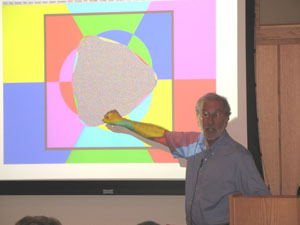- About MAA
- Membership
- MAA Publications
- Periodicals
- Blogs
- MAA Book Series
- MAA Press (an imprint of the AMS)
- MAA Notes
- MAA Reviews
- Mathematical Communication
- Information for Libraries
- Author Resources
- Advertise with MAA
- Meetings
- Competitions
- Programs
- Communities
- MAA Sections
- SIGMAA
- MAA Connect
- Students
- MAA Awards
- Awards Booklets
- Writing Awards
- Teaching Awards
- Service Awards
- Research Awards
- Lecture Awards
- Putnam Competition Individual and Team Winners
- D. E. Shaw Group AMC 8 Awards & Certificates
- Maryam Mirzakhani AMC 10 A Awards & Certificates
- Two Sigma AMC 10 B Awards & Certificates
- Jane Street AMC 12 A Awards & Certificates
- Akamai AMC 12 B Awards & Certificates
- High School Teachers
- News
You are here
Patterns Patterns Everywhere
 The varied gaits of a horse are consequences of the different ways in which the animal moves its feet. These characteristic movements—walk, amble, pace, trot, gallop, bound, canter—serve as visible expressions of different types and degrees of symmetry. They also represent one example of how symmetry-breaking in a simple dynamical system can lead to distinctive patterns and motions.
The varied gaits of a horse are consequences of the different ways in which the animal moves its feet. These characteristic movements—walk, amble, pace, trot, gallop, bound, canter—serve as visible expressions of different types and degrees of symmetry. They also represent one example of how symmetry-breaking in a simple dynamical system can lead to distinctive patterns and motions.
Martin Golubitsky, who heads Ohio State University's Mathematical Biosciences Institute, focused on such symmetric patterns and motions in his presentation "Patterns Patterns Everywhere." As part of the MAA's Distinguished Lecture Series, Golubitsky offered a genial, engaging, and vividly illustrated survey of patterns, both static and dynamic, in physical and biological systems.
We see patterns all around us, Golubitsky began. All we have to do is look.
The mathematical notion of symmetry is a key to understanding how and why such patterns occur, Golubitsky argued. In many cases, changes in symmetry associated with a relatively simple mechanism can produce surprisingly complicated patterns of behavior. Examples include not only the gaits of animals but also patterns in geological formations, shifting flame fronts, convection cells, and even visual hallucinations.
Such patterns also arise in purely mathematical contexts—as visualizations of the behavior of iterative mathematical systems in which symmetry plays an important role. The resulting computer-generated images of symmetric chaos are both complex and familiar, where the chaotic dynamics produces the complexity and symmetry provides the familiarity.
Golubitsky highlighted these and other fascinating patterns and explained their key relationship to mathematical symmetry. He provided intriguing glimpses of and insights into the mathematical and scientific discipline of pattern formation, which underlies much of his collaborative work on symmetry, pattern, and motion.
 An Interview with Martin Golubitsky
An Interview with Martin Golubitsky

This MAA Distinguished Lecture was funded by the National Security Agency.




